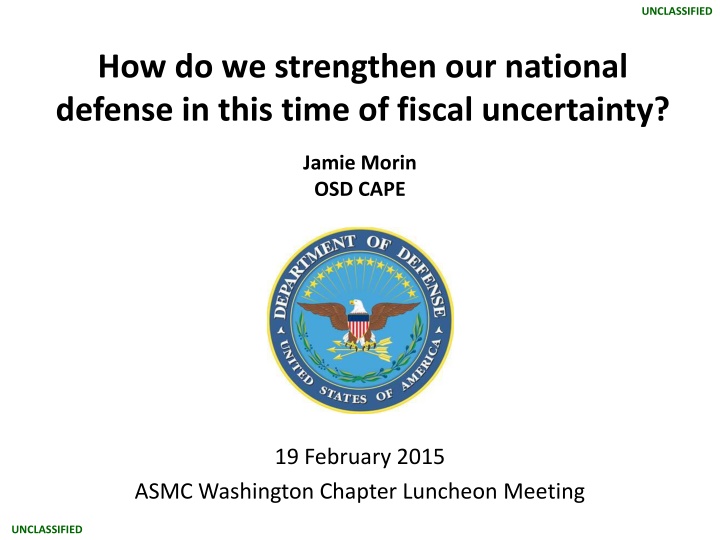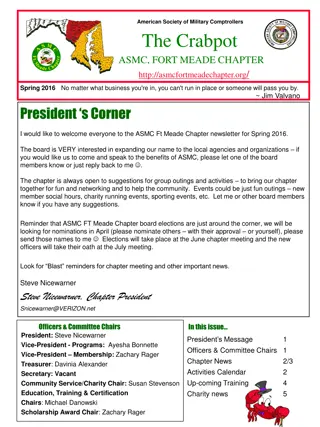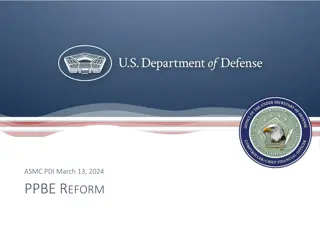
Strengthening National Defense in Times of Fiscal Uncertainty
Discover insights from Jamie Morin's presentation on strengthening national defense during fiscal uncertainty. Explore strategies to align budget with priorities, challenges, and key investment areas for enhancing national security capabilities.
Download Presentation

Please find below an Image/Link to download the presentation.
The content on the website is provided AS IS for your information and personal use only. It may not be sold, licensed, or shared on other websites without obtaining consent from the author. If you encounter any issues during the download, it is possible that the publisher has removed the file from their server.
You are allowed to download the files provided on this website for personal or commercial use, subject to the condition that they are used lawfully. All files are the property of their respective owners.
The content on the website is provided AS IS for your information and personal use only. It may not be sold, licensed, or shared on other websites without obtaining consent from the author.
E N D
Presentation Transcript
UNCLASSIFIED How do we strengthen our national defense in this time of fiscal uncertainty? Jamie Morin OSD CAPE 19 February 2015 ASMC Washington Chapter Luncheon Meeting UNCLASSIFIED
UNCLASSIFIED Agenda Strategy to budget PB15 to PB16 PB16 principles and choices Challenges at BCA Making every dollar count through smarter acquisition Final thoughts 2 UNCLASSIFIED
UNCLASSIFIED PB15 to PB16 PB15 made tough choices but maintained sufficient force structure to meet the strategy Congress rejected many PB15 reforms the Department proposed Compensation Healthcare BRAC Force structure reductions PB16 add resources and tightens our alignment to strategic guidance Balancing joint force capacities, capabilities, and readiness Increased focus on ISR and full spectrum combat readiness Modified resubmit of the reforms Congress rejected Key investments in nuclear deterrence, space, power projection and counter-A2/AD 3 UNCLASSIFIED
UNCLASSIFIED PB16 Request PB16 is shaped by the 2014 QDR strategy Protect the homeland Build security globally Project power and win decisively Department s Priorities Rebalance to the Asia Pacific Maintain a strong commitment to security and stability in Europe and the Middle East Sustain a global approach to countering violent extremists Reinvigorate efforts to build innovative partnerships Keeping faith with and taking care of our service members and their families Leverage the Defense Innovation Initiative Prioritize and protect key investments in technology 4 UNCLASSIFIED
UNCLASSIFIED Key Investment Areas ISR Additional Gray Eagle and Reaper orbits Slowing retirements of legacy forces to meet demand Nuclear Deterrence $8B in additional funding to address shortfalls in the Nuclear Enterprise Infrastructure and ICBM Security force improvements, additional nuclear shipyard workers and force sustainment Space Improving space resiliency and space control to meet the growing threat Power Projection and Counter-A2/AD Additional missile capacity for Virginia class submarines Maintain P-8A Poseidon aircraft for large area anti-submarine warfare Increased funding for electronic warfare systems 5 UNCLASSIFIED
UNCLASSIFIED PB16 Topline We re still living with uncertainty ($B) $675 $655 $635 $615 $595 $575 $555 $535 $515 $495 $475 FY12 FY13 FY14 FY15 FY16 FY17 FY18 FY19 FY20 FY21 PB 2012 PB2013 PB 2014 PB2016 SCMR Sequester Caps 6 UNCLASSIFIED
UNCLASSIFIED Challenges at BCA At the PB16 funding level the strategy can bend without breaking Significant changes coming if forced to fund to BCA levels Reductions in select force structure areas Reduce Army and Marine Corps end strength Cut 11th Carrier and a carrier air wing Reduce FYDP procurement by 8 ships Divesting the Global Hawk Block 40 fleet Cutbacks in modernization and investment PB16 increase in Space control investment is reduced by 70% PB16 increase in Nuclear Enterprise investment is reduced by 40% Break many multi-year/quantity buys of critical capabilities Reduced readiness Reduce Service readiness funding by about $16B over the FYDP Larger maintenance backlogs Delay timeline to achieve joint readiness for full-spectrum operations A mechanical sequester would be even worse 7 UNCLASSIFIED
UNCLASSIFIED Making Every Dollar Count Through Smarter Acquisition Defense acquisition is about balancing valid, competing considerations We cannot have a strong defense with a feeble acquisition process Military comptrollers play multiple roles in the acquisition process Cost analysis advocates Resource risk balancers in PPBE Requirements generators (i.e., capability champions) Proper balancing of these roles is critical to maximizing funding stability and creating a resilient acquisition enterprise 8 UNCLASSIFIED
UNCLASSIFIED Cost Analysis Advocates Strengthening the quality, relevance, and timeliness of cost estimation is key Cost estimates are critical early in programs life cycles Congressional direction to improve cost estimating and acquisition program performance (e.g., WSARA) paid significant dividends Space Fence Cost estimates are a tool to measure the risk of unmanageable cost growth Air Force s Non-advocate Cost Assessments (NACA) were used to reduce cost risk by more than 90% in just 4 years 9 UNCLASSIFIED
UNCLASSIFIED Risk Balancers PPBE has been significantly strained by the fiscal uncertainty we have been facing Threat of BCA reductions have impaired program stability across DoD Build fiscal resiliency into the process by remaining focused on strategy Financial managers need to assess alignment of resources and strategy Balancing short-term and long-term priorities is a challenge Sequestration / continuing resolutions can create vulnerable programs In such environments, financial managers must be engaged to avoid small blips becoming death spirals 10 UNCLASSIFIED
UNCLASSIFIED Capability Champions Capability champions are not program champions Requirements are not set in stone, it only seems that way Sticking to a set of requirements after conditions have changed can be a recipe for acquisition failure or operational failure Focus on the end goal Change requirements and make trades when necessary Seek to remain in the cost-schedule-capability sweet spot Preventing DEAMS from becoming a nightmare Keep asking questions / seeking options Does this make sense? Do we have to have this program? Is there another way to get there? 11 UNCLASSIFIED
UNCLASSIFIED Balancing Challenges Build Security Globally Ends Balance Capacity Protect the Homeland Project Power and Win Decisively Means Balance Capability Readiness 12 UNCLASSIFIED
UNCLASSIFIED BACKUP UNCLASSIFIED
UNCLASSIFIED CAPE Org Chart DIRECTOR, CAPE Jamie M. Morin Front Office Team Principal Deputy Director LtGen Robert E. Schmidle Jr. Cost Assessment Deputy Director Rick Burke Program Evaluation Deputy Director Scott Comes Program, Data, & Enterprise Services Deputy Director Joseph Nogueira Analysis & Integration Deputy Director Vacant Enterprise Services Land Forces Economic and Manpower Analysis Program Analysis Joint Data Support Naval Forces Weapon Systems Cost Analysis Simulation Analysis Center Program Resources & Information Systems Management Tactical Air Forces Advanced Systems Cost Analysis Force Structure & Risk Assessment Projection Forces Operating and Support Cost Analysis Irregular Warfare C4 and Information Programs Strategic Defensive & Space Prgms Force and Infrastructure Analysis Intelligence, Surveillance, & Rec. 14 UNCLASSIFIED
UNCLASSIFIED Historical Topline Afghanistan/ Iraq $800 Global War on Terror $700 21% Korean War Cold War $600 Vietnam War Billions of 2015 Dollars (Total Obligational Authority) 39% 33% 30% $500 $400 Procurement + RDT&E $300 Operations & Maintenance $200 $100 MilPers + Retirement Pay + Family Housing $0 1976 2002 1948 1950 1952 1954 1956 1958 1960 1962 1964 1966 1968 1970 1972 1974 1978 1980 1982 1984 1986 1988 1990 1992 1994 1996 1998 2000 2004 2006 2008 2010 2012 2014 2016 2018 Fiscal Year (FY) Source: Department of Defense Green Book (FY15) Note: OCO is embedded in budget categories in all years prior to FY15; Placeholder OCO amounts are assumed to be in O&M for FY15 19 15 UNCLASSIFIED
UNCLASSIFIED Historical Investment Accounts $300 Afghanistan/ Global War on Terror Iraq But are we done? Korean War $250 Cold War Billions of 2015 Dollars (Total Obligational Authority) 39% Vietnam War $200 71% 51% 50% $150 $100 Procurement $50 RDT&E $0 1976 2002 1948 1950 1952 1954 1956 1958 1960 1962 1964 1966 1968 1970 1972 1974 1978 1980 1982 1984 1986 1988 1990 1992 1994 1996 1998 2000 2004 2006 2008 2010 2012 2014 2016 2018 Fiscal Year (FY) Source: Department of Defense Green Book (FY15) Note: OCO is embedded in budget categories in all years prior to FY15; 16 UNCLASSIFIED
UNCLASSIFIED Balancing Challenges Internal Cost Pressures People Acquisition Operations and Support Fiscal Uncertainty Topline Timing OCO Action on prior requests Strategic & Operational Challenges Shift to Asia away game, geography, & A2AD EM Spectrum Dominance Commercial technological pacing vs DoD OODA Loop Adversary cost imposition 17 UNCLASSIFIED
UNCLASSIFIED FY 2016 President s Budget (Dollars in Billions) By Appropriation Title FY 2015 FY 2016 Dollar Change 136.7 209.8 107.7 69.8 8.4 1.8 534.3 Numbers may not add due to rounding +1.8 +14.5 +14.1 +6.3 +1.9 -0.3 +38.2 Military Personnel Operation and Maintenance Procurement RDT&E Military Construction/Family Housing Other TOTAL 135.0 195.4 93.6 63.5 6.6 2.1 496.1 By Military Department FY 2015 FY 2016 Dollar Change 119.5 149.2 136.9 90.6 496.1 126.5 161.0 152.9 94.0 534.3 Numbers may not add due to rounding +7.0 +11.8 +16.0 +3.4 +38.2 Army Navy Air Force Defense Wide TOTAL Base Budget Request: $534.3 Billion 18 UNCLASSIFIED
UNCLASSIFIED FY 2016 President s Budget Base Budget Budget By Military Department Military Construction Family Housing $8.4 Others $1.8 (Dollars in Billions) Defense Wide $94.0 RDT&E $69.8 Air Force $152.9 Military Personnel $136.7 Army $126.5 Procurement $107.7 Operation & Maintenance $209.8 Navy $161.0 Budget Request: $534.2 billion 19 UNCLASSIFIED
UNCLASSIFIED PB 2016 Significant Modernization Programs 57 Joint Strike Fighters ($10.6B) 16 P-8 aircraft ($3.4B) 5 E-2D aircraft ($1.3B) KC-46 tanker ($3.0B) and Long Range Strike development ($1.2B) 9 ships ($11.6B) George Washington (CVN) overhaul ($678M) Ohio replacement strategic submarine development ($1.4B) Littoral Combat Ship capabilities improvements ($55M) Cyber capabilities enhancements ($5.5B) Ground Based Interceptor reliability ($1.6B) Army helicopter modernization (e.g., Light Utility Helicopter) ($4.5B) Reaper (MQ-9) procurement ($821M) 20 UNCLASSIFIED
UNCLASSIFIED PB 2016 Continues to Pursue Compensation Reform FY 2016 Budget request savings (FY16, $1.7B; FYDP $18.2B) FY16 Basic Pay raise 1.3% (FY 2016, $0.7B; FYDP, $4.3B) Slow growth in Basic Allowance for Housing an additional 4% out-of-pocket above 1% authorized by Congress in FY 2015 (FY 2016, $0.4B; FYDP, $3.9B) Reduce Commissary Operating costs and subsidy through efficiencies and revenue generating opportunities gained through legislative changes (FY2016, $0.3B; FYDP, $4.4B) Consolidate TRICARE healthcare plans with altered deductibles/co-pays to encourage beneficiaries to seek care in the most appropriate setting and improve the overall continuity of care. (FY 2016, -$0.1B; FYDP, $3.1B) Implement modest annual fees for TRICARE-For-Life coverage for retirees 65 and over (FY 2016, $0.1B; FYDP, $0.4B) Additional changes to pharmacy co-pay structure for retirees and active duty family members above the FY 2015 authorized level to further incentivize the use of mail order and generic drugs (FY 2016, $0.3B; FYDP, $2.0B) 21 UNCLASSIFIED
UNCLASSIFIED Overseas Contingency Operations Included with this Budget Request $50.9B Continues decline since FY 2010 Reflects continued operational demands on U.S. forces Continues responsible transition in Afghanistan Includes training and equipping of Afghan security forces ($3.8B) Funds Counter-ISIL Operations ($5.3B) Includes training and equipping of Iraqi forces and vetted moderate Syrian opposition ($1.3B) Includes Counterterrorism Partnerships Fund ($2.1B) Continues European Reassurance Initiative ($789B) Funds International support ($1.7B) Coalition Support Fund Resets/retrogrades equipment ($7.8B) If sequestration lifted, plan to transition enduring costs currently funded in the OCO budget to the base budget beginning in 2017 and ending by 2020 22 UNCLASSIFIED
The FY 2016 Presidents Budget is a Strategy-Driven, Resource-Informed Budget 33 $750 691 687 666 1 666 7 645 601 614* 578 597 27 3 585 591 27 162 581 583 27 159 574 27 560 115 146 534 187 51 8 82 85 64 479 166 $500 468 3 116 437 76 91 73 345 316 17 6 23 $250 287 328 365 377 400 411 431 479 513 528 528 530 495 496 496 534 547 556 564 570 $0 FY13 FY14 FY15 FY16 FY17 FY18 FY19 FY20 FY01 FY02 FY03 FY04 FY05 FY11 FY12 FY06 FY08 FY09 FY10 FY07 Numbers may not add due to rounding * Reflects FY 2013 Enacted level excluding Sequestration DoD Topline, FY 2001 FY 2020 (Current Dollars in Billions) Base Budget OCO Other 23 The $27 million shown in FY 2017 through FY 2020 for OCO are placeholder amounts


















